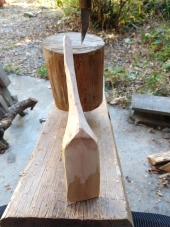
 9
9












 3
3




Splitting Mulberry Wood
Mulberry wood tends to be very popular as a firewood. However, it is not the best firewood out there. After all, this type of wood has a very high-water content. Therefore, this can make it difficult to burn. Still, it is popular for its dense BTU. Just remember that this type of wood is very tough. Therefore, attempting to split it will be much tougher than you could ever imagine. One of the easiest ways to split this type of wood is by using an industrial wood splitter. This is not going to be suitable for everyone though. After all, this equipment can be very expensive.
If you intend to split it manually, you’re going to need a maul, steel wedge, and a sledgehammer. The process can be tedious, but you’ll be able to pull it off. Always look for splits. This can help you find weak grains. Trying to split the wood there will be much easier. https://www.easierhomesteading.com/mulberry-good-firewood/
 3
3




Growing on my small acre in SW USA; Fruit/Nut trees w/ annuals, Chickens, lamb, pigs; rabbits and in-laws onto property soon.
Long term goal - chairmaker, luthier, and stay-at-home farm dad. Check out my music! https://www.youtube.com/@Dustyandtheroadrunners








 3
3




Dustin Rhodes wrote:
(Sorry if this explanation is "talking down" or belittling - I don't know your experience level, and maybe mine isn't even sufficient to get a good answer)
Good luck!
'What we do now echoes in eternity.' Marcus Aurelius
How Permies Works Dr. Redhawk's Epic Soil Series
 3
3












 3
3




steve folkers wrote:In my experience, definitely the first design over the second, though I've used both.
But if it's your first horse, and you need to go from a plan, I'd say stick to the plan.
So I don't understand the mention of a roundwood body.
The compound angle legs are difficult but best, if you can do them. (And you need the bevel gauge.) The through-mortised peg legs are not as simple as they seem, though.
Ideally, also a bench board of a less splittable wood.
I don't want to rain on your parade with quibbles. I'd like you to make your first horse and use it. Then improve and customize your second one, and third and fourth.
Steve Folkers (Judith Browning's husband)
'What we do now echoes in eternity.' Marcus Aurelius
How Permies Works Dr. Redhawk's Epic Soil Series








 2
2








 4
4




 1
1








 4
4











 2
2




- Tim's Homestead Journal - Purchase a copy of Building a Better World in Your Backyard - Purchase 6 Decks of Permaculture Cards -
- Purchase 12x Decks of Permaculture Cards - Purchase a copy of the SKIP Book - Purchase 12x copies of Building a Better World in your Backyard
 6
6




"Ah, but a man's reach should exceed his grasp,
Or what's a heaven for?"
Andrea del Sarto by Robert Browning
 7
7




Every day on this side of the grass is a good day. The first on the other side will be even better.
 4
4




"We're all just walking each other home." -Ram Dass
"Be a lamp, or a lifeboat, or a ladder."-Rumi
"It's all one song!" -Neil Young








 5
5




'What we do now echoes in eternity.' Marcus Aurelius
How Permies Works Dr. Redhawk's Epic Soil Series

|
There's just something sexy about this tiny ad
The new permaculture playing cards kickstarter is now live!
https://www.kickstarter.com/projects/paulwheaton/garden-cards
|







